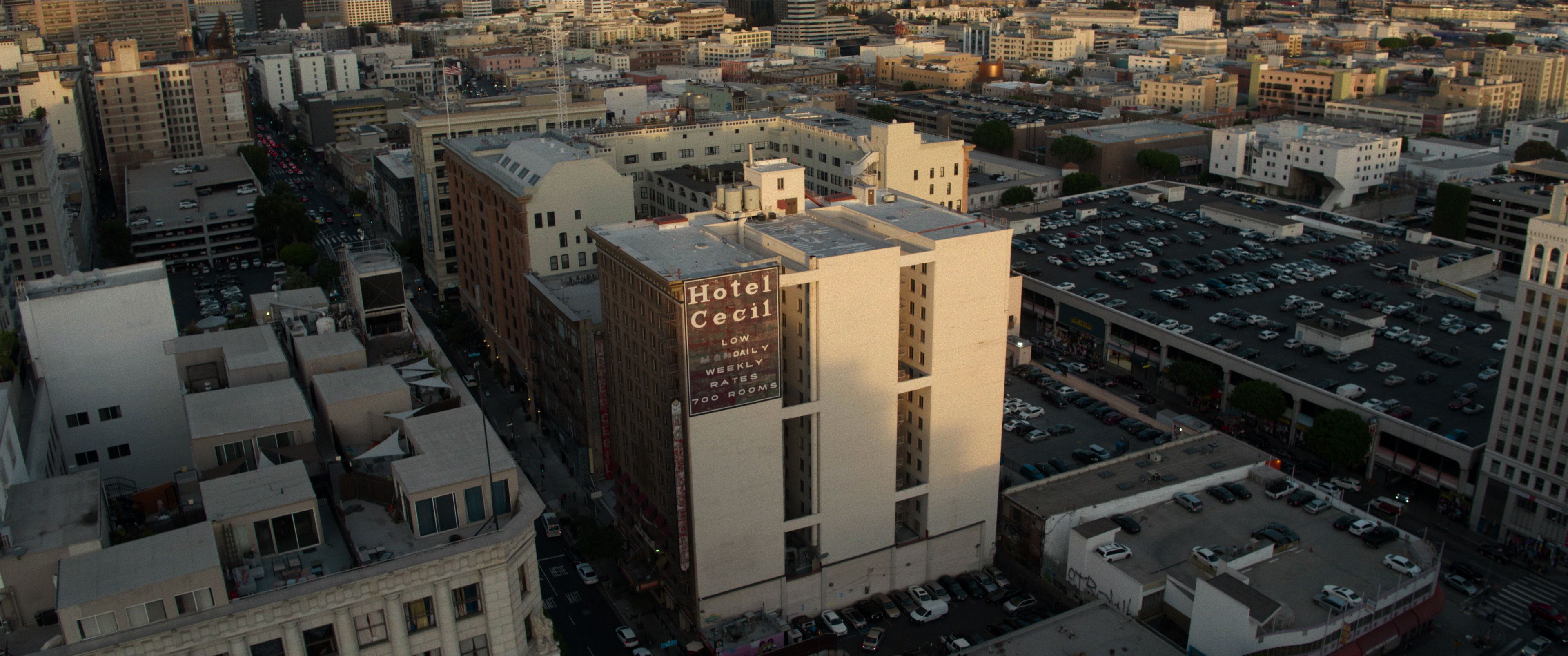Netflix's 'Crime Scene': The Gruesome History of L.A.'s Cecil Hotel
Even before Elisa Lam's death, the hotel had ties to the Black Dahlia and Night Stalker.

Content warning: references to suicide, murder. The devil works hard, but Netflix works harder—at least, when it comes to churning out true crime documentaries. While we were all still reeling from the docs released at the end of last year (The Ripper, anyone?), the streamer has continued to put out a steady stream of new cold case investigations in 2021. First up was The Night Stalker: The Hunt for a Serial Killer, which investigated Richard Ramirez's yearlong crime spree across California in the '80s, and now, Netflix is taking a deeper look at another crime that not only took place in the Golden State but also, interestingly, has ties to Ramirez.
Crime Scene: The Vanishing at the Cecil Hotel delves into the death of Elisa Lam, a 21-year-old who disappeared while staying at the titular downtown Los Angeles hotel in 2013, and was found dead in a water tank on the hotel's roof weeks later, with her death ultimately classified as an accident despite the strange circumstances. The four-episode docuseries is already facing criticism for approaching the tragedy in a way that often feels disrespectful and exploitative, but one undeniably compelling part of the story is its setting, as the Cecil Hotel has a long history of popping up in some of the country's most gruesome crimes. Here's a rundown of the Cecil Hotel's sordid past, from its opulent beginnings in the 1920s to its involvement in the Black Dahlia and Night Stalker cases.
The Cecil Hotel was built in 1924
Amid the financial and cultural boom of the 1920s, the Beaux Arts-style Cecil was officially opened for business in 1927, backed by several million dollars in investments from three hoteliers—totaling about $13 million in modern dollars. It spanned 19 floors, with 600 rooms, and earned an early reputation as a classy place to stay in downtown L.A. Unfortunately for the hotel's owners, within just a few years of the Cecil's opening, the Great Depression sunk in, which not only limited the number of travelers looking for a fancy place to stay, but also turned the area surrounding the hotel into what is now known as Skid Row.
By the 1960s, it was widely known as "The Suicide."
Amid these early struggles for the Cecil, things took a turn for the worse in 1931, when the first documented suicide at the hotel took place. Since then, at least a dozen more have occurred, per L.A.'s PBS affiliate KCET, prompting several of the hotel's long-term residents to begin referring to it as "The Suicide" in the early '60s.
The Cecil was the site of many other disturbing crimes, especially as room prices continued to decline alongside the hotel's changing neighborhood. Throughout the 20th century, the Cecil became a popular hideout for drug dealers, bank robbers, and other criminals, and guests were reportedly robbed, attacked, and even killed. One such occurrence that made headlines in 1964 was the sexual assault and brutal murder of "Pigeon Goldie" Osgood, who had earned her nickname from her habit of feeding the pigeons in nearby Pershing Square, and whose death remains unsolved, according to CNN.
Lam's death is among the most recent of these mysterious deaths at the hotel. As detailed in Netflix's Crime Scene, the Canadian student is believed to have died in the rooftop water tank in early February of 2013, but wasn't found until February 19, after tenants complained about the water pressure. An autopsy, along with security footage from the hotel that appeared to show Lam behaving erratically in the hours before her disappearance, led investigators to conclude that her death was an accident.

The Cecil Hotel in downtown L.A.
The Cecil has a record of involvement in the nation's most infamous crimes.
In addition to its notoriety as ground zero for countless crimes, the Cecil also has a curious habit of popping up in some of the country's most heinous criminal cases, even if they didn't actually take place at the hotel. Elizabeth Short, for one, was reportedly seen at the hotel's bar in the days before her horrific (and still unsolved) murder branded her the "Black Dahlia," though those reports have long been disputed.
Get exclusive access to fashion and beauty trends, hot-off-the-press celebrity news, and more.
Less disputed, however, are the records of Richard Ramirez's stay at the Cecil. The so-called Night Stalker was regularly seen around Skid Row during his mid-'80s crime spree and, as a then-night clerk at the Cecil told the L.A. Times, reportedly checked into the hotel for several weeks in July and August 1985, shortly before his arrest in late August.
Not long after, another serial killer, Jack Unterweger of Austria, reportedly stayed at the Cecil for a time in the summer of 1991 after his previous prison sentence for murder had been cut short due to the belief that he had been successfully rehabilitated. While in L.A. on a reporting assignment, prosecutors eventually found, Unterweger had killed three sex workers.
As a result of this long-standing reputation, the Cecil has been the subject of multiple true crime documentaries and investigations, and served as at least partial inspiration for the fifth season of American Horror Story, which was subtitled Hotel and took place at the "Hotel Cortez" in downtown L.A.
The hotel's owners have tried to rebrand it several times.
After nearly a century of dastardly crimes and eerie occurrences, you would think the Cecil's owners would simply knock down the definitely-cursed hotel and start from scratch. Alas, the building's various owners throughout the years have instead merely attempted surface-level rebrands of the hotel—to little or no effect. In 2007, per KCET, a new ownership group bought the Cecil for $26 million and transformed part of it into the Stay on Main, a boutique mid-priced hotel, though it continued to feature Cecil Hotel branding and to serve as the location of several more crimes.
The hotel has since changed hands once again, with the current owners launching a major renovation in 2016 that would include totally overhauling much of the building's interior. The upgrade is expected to be completed this October, after which only time will tell whether the hotel has finally been given a fresh start.
Andrea Park is a freelance writer for Marie Claire, where she writes mainly about pop culture, drawing on her lifelong obsessions with consuming every book, movie, and TV show she can get her hands on. Andrea is based in Chicago and graduated from Northwestern University's Medill School of Journalism and Columbia University's Graduate School of Journalism. Her byline has also appeared in W, Glamour, Teen Vogue, PEOPLE, and more.
